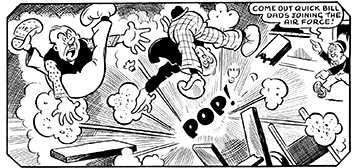
Nobody gets hurt in knockabout – a drawing by John Turner, 1936
“Somebody’s always getting hit, or kicked, or biffed, or boffed!” mused comics artist Bertie Brown in a retrospective interview, seemingly taken aback at the dominant feature of his own work in the inter-war period (cit. Gifford 1972: cover). And indeed it was the prolific Brown himself who had contributed greatly to the spread of hectic antics in British comics. Of course, knockabout in the comics had been known since the work of Tom Browne, Charles Genge, Ralph Hodgson and Frank Holland in the 1890s, artists whose comic strips had presented vagrants and bad boys in all manner of fights and scrapes. Ink lines conveying movement, speed and action, along with rapidly sketched facial expressions suggesting surprise, shock, anger or glee, had rapidly become firmly established in the comic strip artist’s repertoire. By the 1920s, physiologically impossible body contortions combined with goofy antics had become essential ingredients of the comics, the goofiness and hilarity becoming more and more extreme in the post-1930 period. And it was in the “rollicking adventures” created and drawn by Bertie Brown, Alex Akherbladh, George Wakefield, and particularly Don Newhouse and Roy Wilson – these two originally working in creative tandem – and then Reg Parlett in the late thirties, that knockabout reached its turbulent zenith in British comics.
John Turner characterizes this kind of comics mayhem as “knockabout fun” in a chapter entitled “Drawing for the Children’s Comics” in his manual for the budding commercial artist, What the Press Artist Should Know, published in 1936. Turner breaks down such “exaggerated action” into its component parts: “pushing action”, “figures falling or kicking”, “scrapping”, “being tossed or thrown up in the air” (particularly following an explosion), and so on, the last panel of a set generally being reserved for “the villain undone.” He adds a warning: “knockabout actions in the figures should always be treated humorously, otherwise they would suggest tragedy or disaster to the children”. With its dozens of sample illustrations, Turner’s book was undoubtedly a useful repository of tips for the would-be knockabout artist. At the beginning of his chapter, Turner also outlines the impressive size of the market for juvenile comics in the 1930s: twenty-four nationally available weekly comics for children, forty children’s annuals, forty-four magazines which had a comic-strip page or column for the young, plus numerous newspapers and magazines for adults that had children’s sections – a huge market creating “an enormous amount of work for the artist”, for knockabout and nursery artists alike (Turner 112, 121–26).
Knockabout had its home base in this period in the comics known, in contrast to the brightly-coloured nursery comics, as “black comics”, even though most of them were actually printed on tinted paper, green, blue, pink or yellow. Following price standardization at the Amalgamated Press in the autumn of 1922, they cost a penny (1d) apiece, a price that seemed to have fallen within the discretionary pocket money of lower-middle-class and working-class youngsters, particularly boys. These “black comics” included the old stalwarts Funny Wonder, Chips, Comic Cuts and Merry and Bright along with the newcomers Joker and Larks and many more. Other publishers – Fleetway Press, United Press, Target Publications, Provincial Comics – brought out their own penny comics featuring similarly wild knockabout on their cover pages, back pages, and middle pages. The overall circulation of these comics was high. In its heyday in the 1930s, Chips alone reputedly sold a million copies per week (Baker [2]). Nor were these comics only available in England, Scotland, Wales and Ireland. Many “overseas editions” were distributed through agents in Canada, Australia, New Zealand and South Africa, the shipped-out versions generally consisting of one or more comics folded or stapled inside one another. The knockabout comic was evidently a viable export.